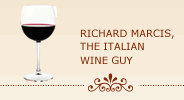A Tasting of Pre-release 2005 Barolo and 2006 Barbaresco Wines
I recently had the opportunity to taste some of importer Neil Empson’s fine line of Barolo and Barbaresco wines from the 2005 and 2006 vintages, respectively, which have not yet been released for sale. DOCG rules require Barolo wines to age for a minimum of three years, two of which must be in wooden barrels, while a Riserva has to be aged for five years. Barbaresco wines must have a minimum of two years of ageing, one of which must be in wooden barrels. A Riserva must be aged for a minimum of four years, one of which must be in wooden barrels. The ‘05 Barolos will be released for sale beginning in March and the ‘06 Barbarescos at about the same. Since they have yet to be released prices are not currently available.
The Barolo and Barbaresco zones are relatively close together with only a few miles separating them. The Barolo DOCG area lies just southwest of Alba in Italy’s Piedmont region and includes the vineyards on the hills around the towns of Barolo, La Morra, Castiglione Falletto, Serralunga d'Alba and Monforte d'Alba. The Barbaresco DOCG zone lies just east of Alba and encompasses the villages of Barbaresco, Neive and Treiso. There two zones are in close enough proximity that they generally experience the same weather. If it’s a good year in one zone it typically is an equally good zone in the other and vice versa. While individual producers or wine cognoscenti will sometimes draw weather-related distinctions between the two zones, I generally find their arguments underwhelming.
My overall assessment is that the quality of the ’05 wines from the Langhe (referring to that part of the Piedmont region where Barolo and Barbaresco are produced) is almost but not quite as good as the ’04 vintage. But this is not faint praise. 2004 was a great year in the Langhe with favorable weather throughout the growing season and plentiful rainfall at the right time almost as if on demand. The end result is an outstanding vintage that resulted in well-balanced wines with good acidity, fruit and soft tannins that while cellar worthy are also drinking well now.
By comparison, it was a hot and dry summer in the Langhe in 2005 with rains late in the growing season which required harvesting the Nebbiolo grapes a few weeks earlier than usual. The ’05’s have a wonderful garnet color and good structure and complexity. However, they appear to be somewhat more subdued and less expressive at this point relative to the previous vintage. But not everyone shares my assessment. For example, the ’05 vintage is a particular favorite of David Mozzole, owner and winemaker at Bongiovanni, who indicated that he considers it every bit as great as the ’04 vintage and perhaps even a touch better.
The weather in the Langhe in 2006 was all over the ballpark. Following a cool and wet spring the weather turned sunny and hot but not as extreme and parched as in 2003. Then the rains came and the weather turned cooler in August while September brought sunshine and intermittent rains. Certainly a challenging year but not necessarily a bad year and many producers are reporting good to excellent results.
Empson imports wines from around the world but specializes in Italian wines. The company has a stable of remarkable, quality-oriented producers of Barbaresco and Barolo in its line-up that includes Einaudi, Marcarini, Poderi Colla Conterno Fantino, Ca’ Rome and Bongiovanni. Below are my notes on the wines tasted just last week.
Ca’ Rome
The Ca’ Rome estate is located at the top of a Langhe hill called Rabajà, one of Barbaresco’s historic crus. The estate also owns property in Serralunga d’Alba, which is in Barolo country so they produce Barolos as well as Barbarescos. The Barolo and Barbaresco wines of Ca' Rome are generally traditional in style with most spending time in large oak barrels. Ca’ Rome, like Poderi Colla and Marcarini, have managed to keep prices of their Barolo and Barbaresco wines very reasonable in recent years and I would expect the same great values on their new releases.
Ca’ Rome, Barbaresco DOCG 2006 - the bouquet is muted although some energetic swishing in the glass brings up some berry aromas. Very austere and tannic and will need time to develop. Good
Ca’ Rome, Barbaresco “Söri Rio Sordo” 2006 - soft and velvety, a big, luscious wine. Rustic with some good ripe berry and plum character. Medium-to-full body, moderate acidity and soft tannins that flow into a long, clean finish. Very good.
Ca’ Ro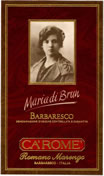 me, Barbaresco “Maria di Brun” 2006 - only made in the best years from a special selection of late-ripening Nebbiolo grapes that spend 2 years in large oak barrels as well as some time in barriques. While the bouquet was initially a little closed, a little time inthe glass and some swirling brought out a mélange of herbal andspice aromas. A rich,opulent wine with a good tannic structure that is still evolving. Outstanding.
me, Barbaresco “Maria di Brun” 2006 - only made in the best years from a special selection of late-ripening Nebbiolo grapes that spend 2 years in large oak barrels as well as some time in barriques. While the bouquet was initially a little closed, a little time inthe glass and some swirling brought out a mélange of herbal andspice aromas. A rich,opulent wine with a good tannic structure that is still evolving. Outstanding.
Ca’ Rome. Barolo “Vigna Cerretta” 2005 - from a single vineyard in Serralunga d’Alba, this is the star of Ca’ Rome’s impressive lineup. Aromas of sweet spice and cedar leap out of the glass. It has a big, rich mouth feel but is well balanced with good acidity and soft tannins so it doesn’t lose its sense of style and subtlety. Outstanding.
Ca’ Rome, Barolo “Rapet” Gold Label 2005 – the bouquet is very muted. Medium to full body with well balanced and firm tannins. Very good.
Conterno Fantino
The Conterno Fantino estate is located on a hill overlooking the old village of Montforte d’Alba. The winery’s best wines come from Sori Ginestra, a historic Barolo cru.
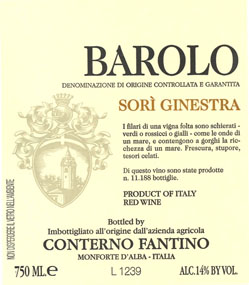 Conterno Fantino, Barolo “Sori Ginestra” 2005 – the bouquet is initially muted but gradually opens up to reveal dark, deep fruit and sweet spice aromas. While not as powerful as the ’04 rendition, it is still generous in every way with great depth and richness, sweet tannins and a long finish. A great single-vineyard definition of Barolo. Outstanding.
Conterno Fantino, Barolo “Sori Ginestra” 2005 – the bouquet is initially muted but gradually opens up to reveal dark, deep fruit and sweet spice aromas. While not as powerful as the ’04 rendition, it is still generous in every way with great depth and richness, sweet tannins and a long finish. A great single-vineyard definition of Barolo. Outstanding.
Conterno Fantino, Barolo “Vigna Del Gris” 2005 – an initially musty nose opens to reveal spice and black plum aromas. There is nothing reticent about this modern-style Barolo - it is big, rich and coats your tongue and teeth with velvety tannins. Very good.
Conterno Fantino, Barolo “Mosconi” 2005 – this single-vineyard wine is from a parcel of land close-by Sori Ginestra but at a higher altitude. The bouquet is musky with balsamic accents. A solid, full-bodied, well structured Barolo with some dark, deep, flavors that are super-rich and chewy in the mouth. Outstanding.
Einaudi
The Luigi Einaudi winery is in Dogliani, an unprepossessing small town a few miles south of Alba that is known primarily for the high-quality Dolcetto wines produced there. Einaudi produces some outstanding Barolos as well as Dolcettos and the estate’s 2005 Terlo, Costa Grimaldi and Cannubi Barolos get especially high marks.
Einaudi, Barolo “Terlo” 2005 – classically vinified and aged in oak for two years, this wine has intense and profuse aromatics and complex layers of fruit. It is a mouth-filling, big wine, rich and plush but with a good lingering finish. Resist the temptation to drink now. It should be cellared for at least 10 years to realize its full potential. Outstanding.
Einaudi, Barolo “Costa Grimaldi” 2005 – the Nebbiolo grapes are hand selected from the Costa Grimaldi vineyard in the Terlo cru for this outstanding wine. It has a delicate bouquet with floral accents. It is plush in the mouth with fairly rich berry fruit supported by moderate acidity and sweet tannins that segue into a clean, graceful, berry fruit finish. Its one of those wines you hate to spit out at a tasting. Outstanding
Einaudi, Barolo “Cannubi” 2005 – this wine has amazing concentration and structure attributable in large part to 18-20 months spent in French barriques and 12 months in oak barrels. This cellar-worthy wine from one of Barolo’s most celebrated crus will gain tremendous complexity with age. Be patient and wait with this one. Outstanding.
Einaudi, Rosso delle Langhe “Luigi Einaudi” DOC 2005 – I couldn’t resist the temptation to include this cuvée that I sampled at the Empson tasting. It is composed of equal parts Nebbiolo, Barbera, Cabernet Sauvignon and Merlot and is aged in barriques for 18 months. Intense garnet in color, it is soft and full-bodied with good aromatics and subtle spice notes on the finish. The sultry fruit of the Cabernet Sauvignon is enhanced by the plush qualities of the Merlot while the Nebbiolo and Barbera add depth and structure. It will be released in July, 2009. An outstanding Rosso delle Langhe.
Marcarini
Marcarini is one of the few Piedmont wineries that can claim the mantle of Barolo royalty. Established in the 1850’s in the commune of La Morra, it was one of the first wineries in the area to designate single vineyards on its labels. Its historic, contiguous cru vineyards of Brunate and La Serra are two of La Morra’s top vineyards and they have over the years been one of the most reliable producers of traditionally-crafted Barolos.
Marcarini, Barolo “La Serra” 2005 – offers up aromas and flavors of red raspberries and cherries. With medium body supported by mild acidity and soft tannins it emphasizes elegance as opposed to power and strength that characterize many traditionally-crafted Barolos. This wine has only been in the bottle since December ‘08 and won’t be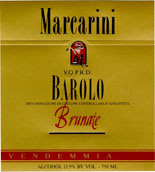 available to the public for another three months. It should be ready to drink upon release. Very good.
available to the public for another three months. It should be ready to drink upon release. Very good.
Marcarini, Barolo “Brunate” 2005 – a little swirling unleashes a host of vanilla and sweet spice aromas. Full in the mouth with balsamic flavors and soft tannins. It is a big and complex wine similar to the ’98 and ’00 Brunates. A formidable effort from a great producer. Outstanding.
Poderi Colla
The Poderi Colla estate is comprised of three distinct properties - Cascine Drago near Alba, Tenuta Roncaglia, which takes its name from the historic cru of Roncaglia south of Barbaresco; and Tenuta Dardi Le Rose, which is in the renowned Barolo Bussia cru in Montforte d’Alba.
Poderi Colla, Barbaresco “Roncaglia” 2006 – aged in oak casks for 12 to 14 months and bottled without filtering, the Roncaglia emphasizes elegance and complexity over power and excess. The bouquet is a complex tangle of bright red fruit aromas. It has a medium body with sweet tannins and a long, persistent finish. Very good.
Poderi Colla, Barolo “Bussia” 2005 – this wine spends 24-28 months in oak casks and like the Roncaglia is bottled without filtering. The bouquet doesn’t need any coaxing as dark fruit aromas fairly leap out of the glass. A big and complex wine with considerable grip and structure that displays classic Barolo characteristics - expansive red and dark fruit, truffles, and sweet spice flavors and firm tannins. Although already showing depth and complexity, this wine should be cellared for at least 5 to 7 years to show its best potential. Outstanding.
Poderi Colla, Pinot Nero Langhe “Campo Romano” DOC 2006 – this is another wine from the Empson tasting that I think is worth highlighting even though it doesn’t fit in with the Barolo – Barbaresco theme of this report. Produced from old Pinot Noir (Pinot Nero as its known locally) vines, the wine spends 8 to 12 months in oak barrels of which 10 to 15 percent are new barriques. While Burgundian in its sensibility it exhibits an exuberant Italian personality. Dark, rich and intense, its dark cherry and berry fruit flavors give way to a generous, velvety, decadent mouth feel with plenty of structure. Outstanding Pinot Nero.
Bongiovanni
Founded in the early 1950’s, Cascina Bongiovanni is a small, family-owned winery in the historic village of Castiglione Falleto that produces relatively small quantities of Barolo and other Langhe classics. Bongiovanni’s wines are decidedly modern in sty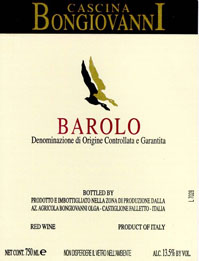 le with use of barriques and short maceration periods.
le with use of barriques and short maceration periods.
Bongiovanni, Barolo 2005 – the estate’s regular Barolo bottling spends a minimum of 24 months in French barriques and is bottled without filtering. A subtle bouquet that opens hesitantly to reveal focused aromas of dark red fruit and sweet spices. Medium-bodied wine with elegant but restrained red fruit flavors and balanced acidity and tannins. Good.
Bongiovanni, Barolo “Pernanno” 2005 – hand selected Nebbiolo grapes from one plot within the estate’s finest vineyard. The grapes are intentionally harvested several days after the regular Barolo harvest which makes for a more concentrated almost “passito-like” wine. Seductive dark red fruit and sweet spice aromas. A rich, plump fouth feel with good acidity and beautifully structured tannins. Very good.
Bongiovanni, Rosso delle Langhe “Faletto” 2006 – this is another wine worth noting even though it doesn’t fall into the Barolo - Barbaresco focus of this report. It’s a blend of 50 percent Cabernet Sauvignon, 30 percent Barbera and 20 percent Nebbiolo which are aged separately in French oak barriques and then blended after 12 to 18 months. Intense garnet color with a bouquet that jumps out of the glass with plum, blackcurrant and vanilla aromas. Full-bodied with excellent structure and soft tannins and a long, lingering finish with subtle spice notes. An outstanding Rosso delle Langhe.
©Richard Marcis
WineWordsWisdom.com
return to wine review and musings »»

